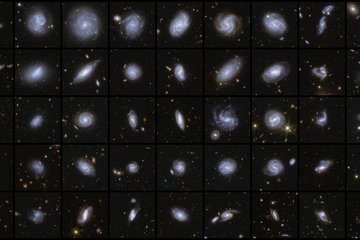Euclid space telescope catches its first glimpse
German research institutes are pleased with the first test images
Euclid, ESA’s newest space telescope with strong German participation, has delivered its first test images a few weeks after the rocket launch. They already show excellent image quality. Euclid has two cameras: the VIS camera provides high-resolution images in visible light. In contrast, the NISP camera measures infrared light and produces images and spectra. With the data from VIS and NISP, the six German institutes of the international Euclid consortium hope to gain insight into the influence of dark matter and dark energy on the structure of the cosmos and to understand the first objects in the early universe.

The reactions of the members of the Euclid consortium are enthusiastic. “Although these first test images are not yet usable for scientific purposes, I am pleased that the telescope and the two instruments are now working superbly in space,” says Knud Jahnke from the Max Planck Institute for Astronomy (MPIA) in Heidelberg. He is one of the two instrument scientists of Euclid’s Near Infrared Spectrograph and Photometer (NISP).

Both VIS and NISP provided these unprocessed raw images. Compared to commercial products, the cameras are immensely more complex. VIS comprises 36 individual CCDs with a total of 609 megapixels and produces high-resolution images of billions of galaxies in visible light. This is how astronomers determine their shape. The first images already give an impression of the abundance that the data will provide.
NISP’s detector consists of 16 chips with a total of 64 megapixels. It operates in the near-infrared at wavelengths between 1 and 2 microns. In addition, NISP serves as a spectrograph, which splits the light of the captured objects similar to a rainbow and allows for a finer analysis. These data will allow the mapping of the three-dimensional distribution of galaxies.
Thus, onboard Euclid is the largest imaging plane in the history of science to date. After just a few days, Euclid will have sent more scientific image information to Earth than the Hubble Space Telescope did in its 33 years of work.

The Max Planck Institute for Astronomy (MPIA) and the Max Planck Institute for Extraterrestrial Physics (MPE) in Garching contributed critical components to the optics. The four lenses of the NISP instrument, which measure up to 18 centimetres and weigh 2.5 kilograms, also form the largest objective ever launched into space. With an accuracy of less than 1/10 of the diameter of a human hair, it is also the best-adjusted objective of all space missions. Entirely new methods of manufacturing and aligning the lenses had to be devised to achieve the necessary accuracies.
Frank Grupp (MPE and Ludwig Maximilian University in Munich), the optical architect of NISP and responsible for the construction and alignment of the instrument’s main optical components, admits: “When I felt the rumble of the engines in my stomach and chest during the launch of the Falcon 9 rocket with Euclid on board at a distance of almost 9 kilometres from the launch site, I had to think about ‘my’ lenses, which were exposed to far greater vibrations only a good 60 metres away from the engines. Although we tested everything well and with sufficient safety, I was happy to see on the first pictures that our optics are intact and will work excellently according to expectations.”
This success was only possible thanks to the cooperation of the excellent staff in the Euclid consortium, the German Aerospace Centre (DLR) and industry partners. “After 16 years of work for Euclid, we can be proud that the telescope is now opening its eyes and looking into space, thanks in part to our efforts,” adds Grupp.

Now the work begins for the engineering and science teams to adapt the settings developed on Earth to the actual space environment and calibrate the instruments. The results will give Euclid’s extensive data processing software the information it needs to compute optimised images of the VIS and NISP instruments and provide scientists with a tool for exploring the dark universe.
“We are very pleased that the commissioning phase of Euclid is progressing well,” says Alessandra Roy, Euclid project manager at the German Space Agency at DLR. “The spacecraft will soon reach its final position at a distance of 1.5 million kilometres from Earth and begin scientific observations. Then Euclid will shed light on the dark side of the universe.”
Euclid will systematically study the influence of dark matter and dark energy on the evolution and large-scale structure of the cosmos for the first time from space. Together, these largely unknown and invisible components of the universe account for 95 per cent of the cosmos. While dark matter determines the gravitational effects between and within galaxies and initially caused the universe’s expansion to slow down, dark energy is responsible for the current accelerated expansion of the universe.
Background information
Euclid is a space mission of the European Space Agency (ESA) with contributions from the National Aeronautics and Space Administration (NASA). It is the second M-class mission in ESA’s Cosmic Vision programme.
VIS and NISP were developed and built by a consortium of scientists and engineers from 17 countries, many from Europe, but also from the USA, Canada and Japan. From Germany, the Max Planck Institute for Astronomy (MPIA) in Heidelberg, the Max Planck Institute for Extraterrestrial Physics (MPE) in Garching, the Ludwig Maximilian University (LMU) in Munich, the University of Bonn (UB), the Ruhr University Bochum (RUB) and the German Space Agency at the German Aerospace Centre (DLR) in Bonn are participating.
The German Space Agency at DLR coordinates the German ESA contributions. Also, it provides funding of 60 million euros from the National Space Programme for the participating German research institutes.
With around 21 per cent, Germany is the most significant contributor to the ESA science programme.















